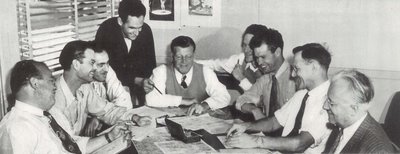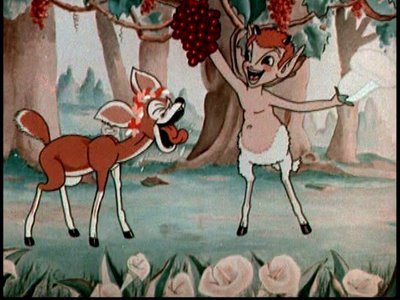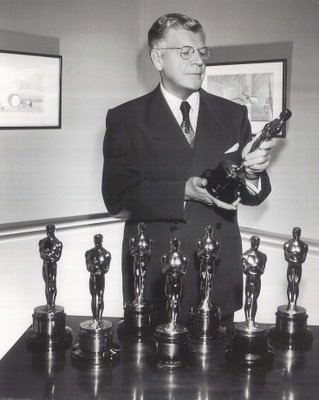

Get Out and Sell Those Cartoons! --- Part Two
I did had some conversations with TV programmers from the Indianapolis area who gave me a vivid recap of what it was like buying and scheduling cartoon packages from the fifties through the seventies. According to these veterans, television appetite for kid product was insatiable. One independent manager recalled having three separate children's shows each day, and he was constantly on the lookout for animated material. Excessive repetition of cartoons was something to be avoided. Fresh stock was at a premium. A non-affiliated channel would buy up every package available, so long as the price was reasonable (neither of the station managers I spoke to remembered playing that MGM 1960 group, by the way). The deal on cartoons called for unlimited runs over a five to seven year license period. Terms were based on the size of your market. A typical group of several hundred cartoons might go for ten to twenty thousand in the Indianapolis market. Salesmen were determined and persistent. A programming director received a half dozen "cold-calls" on any given day from field men dropping by after an appointment with a rival station. A lot of these former drummers to theatres, and for some it was hard making the adjustment to TV sales. There were many occasions when they would come through the door with no real knowledge of the product being offered, but armed nonetheless with a pitch man’s bravado and the firm resolve to close a deal. One seller always wore a cape, which he removed with flourish upon entering the customer’s office. Another would follow any unsuccessful spiel by slamming shut his briefcase, snapping the fasteners, and apologizing with theatrical emphasis for not having done a better job for my company. These men sold the cartoons we watched every day on TV, but most didn’t know Droopy Dog from Dill Pickle. They might as well have been selling radial tires. A good field man was rewarded with placement in one of the major markets --- Chicago, LA, Houston. Beginners and non-starters scrambled amongst low wattage remnants, and that meant a lot of drive time hopscotching from one underfunded broadcaster to the next. Having bought a cartoon package, you were free to program it any way you liked. Goonland might play four times a week on the Popeye and Janie Show, while The Organ Grinder’s Swing never showed up once, but only because someone in the film room mislaid it among Industry On Parade shorts. Rhyme and reason often went begging when it came to local programming. Employees in charge of projection would grab anything within reaching distance. You’d see Daffy Duck In Hollywood enough to figure it must be sitting beside the operator’s lunchbox, and he’s threading up that same cartoon day after day while finishing his Little Debbie snack cakes.




Bravo to Warners for including so many MGM cartoons as extras with their classic DVD offerings. Several dozen have accumulated so far. I wish someone would compile an index of all the titles and where they’re located. I found The Milky Way with A Night At The Opera. Poor Little Me showed up with David Copperfield. I’ve tried to look at all of them, but I’m sure I missed some. Harman/Ising two-color Technicolor shorts are particularly interesting, coming about as the result of Metro's being foreclosed from using the new three-color system. Walt Disney had locked up exclusive rights after committing his Silly Symphonies to the process in 1932. This was a three-year deal, and no one else stood a chance competing with the rich, full palette of his already superior product. No matter how accomplished their animating skills, MGM artists couldn’t approach the Disney standard as long as they were restricted to such a limited spectrum. Tales Of the Vienna Woods and The Calico Dragon are notable, not for the colors they display, but for ones they cannot. I missed blue and yellow the most. You can’t blame it on bad prints, as these Warner transfers are the best available from original elements (note sample frames shown here). I played one of the Harman/Isings back-to-back with a Silly Symphony. The difference was night and day. Quality control was not a priority at Metro. You didn’t have someone like Walt riding herd to get out the best cartoon possible. He spent upwards of $50,000 on each subject by the mid-thirties. MGM tried to hold the line at less than half that. Average negative cost for the 1934-35 season was $15,209, and rentals averaged $44,157. Hugh Harman wanted to compete with Disney by spending more. His profligacy resulted in downward profit margins. 1935-36 saw costs rising to an average of $28,060, but at least three-color Technicolor was by available, Disney’s exclusive license having expired. Subjects like Honeyland and Bottles give the Silly Symphonies a run for their money in terms of visual splendor. Developing ongoing characters for their cartoons was where MGM fell down. The Captain and The Kids was based on a comic strip that had been around forever, but audiences still weren’t buying. The Captain’s Christmas, at a negative cost of $27,419, brought back only $25,358 (the loss was even more keenly felt when you figured the total cost with prints, $38,605).



MGM made cartoons in order to resist the encroachment of double features. To persuade a theater not to book a second movie, they had to offer a complete program. Toward that end, the studio maintained a broad selection of miniatures (as shorts were often referred to in those days). Trade ads unmasked the evils inherent in combo billing, with the example shown here proposing an extreme remedy for one who has violated the orthodoxy of a well-balanced presentation. As long as they sought to provide an entire evening's bill of fare, MGM was obliged to make cartoons available to exhibitors. Once they established an in-house animation division in 1937 (its Culver City location shown here), the company was able to assure profits for their also-ran subjects. The Milky Way even managed to win the Academy Award for Best Animated Short Subject in 1940. This was an example of a Metro cartoon that made money and kept on making money. Initial negative cost was $29,416, and rentals for its first release were $44,060. A re-issue in 1948 yielded an additional $65,513. Ten years later (1958), $50,792 more. Finally in 1963, at a point when The Milky Way was presumably playing television (even if in precious few markets), another revival brought in $30,839. Quite a balance sheet, with theatrical rentals topping $200,000 on a negative investment of just $29,416.
Photo Captions
A Gathering Of Eagles: (left to right) Director Tex Avery; Background Artist Dan Shaffer; Story Man Harvey Eisenberg; Director Joseph Barbera; Producer Fred Quimby; Superintendent C.G. Maxwell; Director Bill Hanna; Sound Effects Technician F. McAlpin; Musical Director Scott Bradley.
A Two-Color frame from Tales Of The Vienna Woods (1934)
Producer Rudolph Ising, right, and W.D. Burness, animator.
Producer Fred Quimby regards his Oscars.
A Three-Color Technicolor frame from The Fishing Bear (1940)
One-Sheet for Tee For Two
Co-directors Joe Barbera and William Hanna at work on Tom and Jerry.
MGM's Animation Building
Typical hard-hitting MGM Trade Ad denouncing double features.
6 Comments:
Sometimes there were practical reasons for certain cartoons showing up frequently. There was a cartoon in the Warner pre-48 package called "September in the Rain" that kids in our market probably got sick of, but the reason it got programmed so often is that it was unusually short, having been heavily edited by UA in the late '60s to remove racial material. The abbreviated running time made it handy to throw in whenever "Bugs Bunny and Friends" ran short.
Has Bottles been released on any DVD? I saw a 35mm print at Cinevent a couple of years ago and it certainly showed Harman-Ising getting within shouting distance of Disney's artistry-- at least once in a while.
"Bottles" in on the Warner DVD of "San Francisco."
Anybody out there remember watching Boston's Ch.38 in the early 70s?Someone convinced them to buy the weird Eurotoons that comprised the "Nutty Squirrils" package, and those auful "Mel-o-Toons" based on kiddie records.I think the "Squirills" 'toons were mostly from Czechoslovakia and Russia, and included a Russian "Pinocchio"
Hey, "September in the Rain" shows up as an extra on one of the latest Astaire-Rogers movies just released to DVD--I think it's The Story of Vernon and Irene Castle. It makes sense to include it, because the cartoon ends with Astaire and Rogers-like cartoon characters dancing up and down matchboxes a la the dance over the chairs and table at the end of The Gay Divorcee (though one wonders why the cartoon wasn't an extra on the TGD DVD).
Apparently the reason "September in the Rain" was edited was that an Al Jolson character sings the titular song in blackface.
MGM cartoons are OK, but nothing ever could beat Warner Brothers for that snappy, adult quality and marvelously fluid animation their pre-1950s cartoons had.
I know the dot and the line is on the Australian edition of the Doris Day/Frank Tashlin film the glass bottom boat. I'm not sure about in America, though.
Post a Comment
<< Home